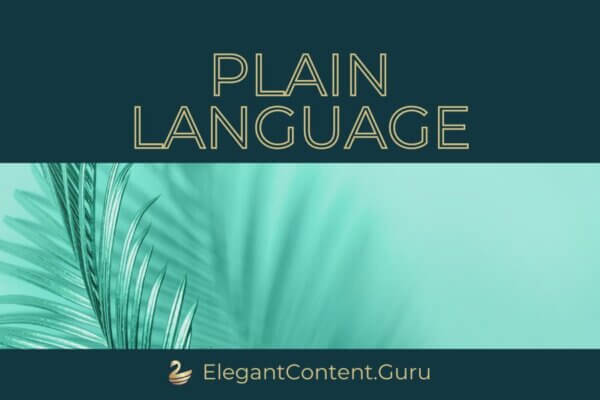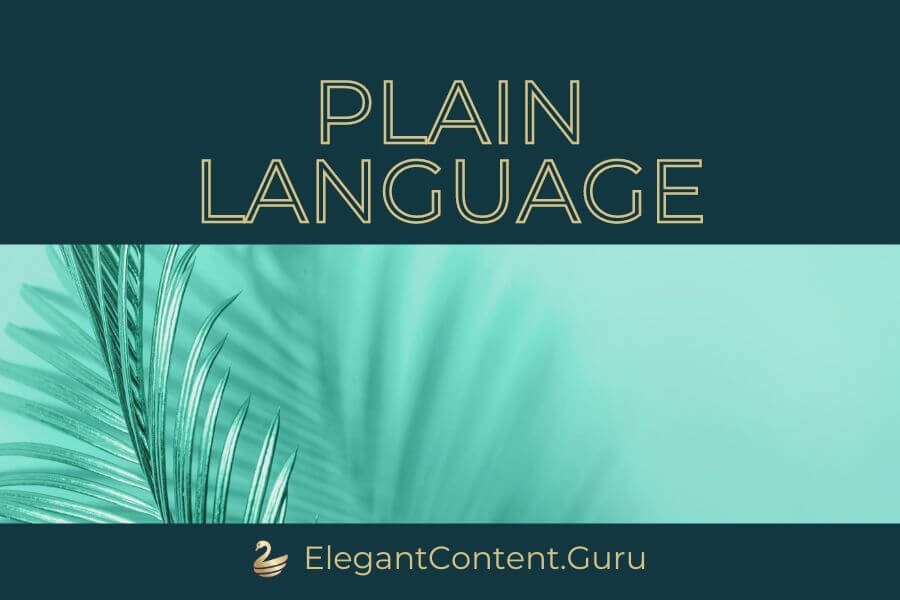Content writing is an essential tactic for an effective marketing strategy. However, one of the most effective ways to engage your audience is by using plain language writing. In this complete guide, we explore the power of plain language for content writing, why it’s essential, and how to use it in your writing. We cover everything from its benefits to specific techniques to use to make your content more accessible and engaging.
A Useful Guideline to Connect with Your Readers
Quick Thoughts About Writing in Plain Language
- The average adult reads at a U.S. eighth-grade level (about 12-14 years old).
- Write in the second person (you) whenever possible.
- Use the active voice (i.e., “the leopard chased the antelope” rather than “the leopard was chased by the antelope”)
- Use the present tense (i.e., “The river flows through the city”)
- Use simple verbs (i.e., “use” instead of “utilize”)
- Write in short sentences (15 words or less and no more than 25 words)
- Don’t use jargon (i.e., archaic jargon, “hereafter” “heretofore” and “therewith”)
What is Plain Language?
Plain language is a writing style that is concise, and easy to understand. It focuses on using clear language, providing information in a logical order, and avoids jargon or complex terms. The main goal of writing in plain language is to ensure that a broad audience comprehends the content, regardless of their reading abilities or background knowledge.
Plain Language Misconceptions
There are several misconceptions about plain language that sometimes stops writers from using this style. Some common misunderstandings include the following:
• Plain language is boring.
Contrary to this belief, plain language is not dull or uninteresting. In fact, by design, it makes your content more engaging by keeping it easier to read and comprehend.
• Plain language oversimplifies ideas.
Writing in plain language does not mean you simplify your ideas. Instead, it’s about presenting complex ideas in a way that’s easy to understand.
• Plain language is less intelligent.
Writing in plain language requires skill and effort, as it involves carefully choosing words and phrases to effectively convey your message. And no, it does not reflect a lack of intelligence or sophistication on the writer’s part.
The Importance of Plain Language
Using plain language in content writing is essential for several reasons:
• Easier to understand.
Plain language makes your content more convenient to a wider audience. This also includes those with reading difficulties or non-native English speakers.
• Less time-consuming.
Content in plain language takes less time to read and comprehend. So, naturally it makes it more likely that your audience will engage with your content.
• Improved user experience.
Plain language makes it easier for readers to quickly find the information they want. As a result, it leads to a better overall experience with your content.
• Positive business impact.
Research shows that people prefer reading content in plain language. In fact, businesses that provide clear and concise information often receive fewer questions and complaints. As an example, this is why it’s the standard for the Oregon State government.

How to Write in Plain Language
There are several techniques you can use to write engaging, plain language content. In this section, we outline some key tactics for your writing strategies.
• Keep sentences short.
Short sentences are easier to read and understand. Therefore, go for an average sentence length of 15-20 words. Also, avoid sentences longer than 25 words. To shorten your sentences, remove unnecessary words or split long sentences into two shorter ones.
• Use simple words.
Choose simple words that convey your message without confusing your audience. Also, avoid using jargon or technical terms. Of course, it’s easy to replace long, complex words with shorter alternatives by checking your synonyms. Remember, your goal is to make your content as easy to read as possible.
• Use active voice.
Using active voice makes your writing more direct and easier to understand. In the active voice, the subject performs the action (e.g., “The dog chases the cat.”). In contrast, passive voice sentences are more complex and harder to understand (e.g., “The cat was chased by the dog.”). So, stick to active voice whenever possible.
• Give clear instructions.
Be direct when providing instructions or guidance. Doing so makes your content easier to follow. Plus, don’t worry about sounding rude because readers appreciate clear and simple writing more than you may know.
• Use pronouns.
Use pronouns like “you,” “we,” and “I” to create a more personal connection with your readers. It also makes your content feel more like having a conversation. Avoid using formal language, as this makes your content harder to understand.
• Avoid nominalization.
Nominalization is the process of turning a verb or adjective into a noun (e.g., “react” becomes “reaction”). This makes your sentences longer and more difficult to read. Instead, use the original verb or adjective to keep your writing clear and concise.
Here is a PDF Courtesy of Cedarville University Writing Center
Powered By EmbedPress
Formatting Techniques for Plain Language
The right formats significantly enhance the ease of reading of your content. Here are some formatting techniques to consider when writing in plain language:
• Use headers and subheaders.
Headers and subheaders help break up your content into manageable sections and make it easier for readers to find the information they want. All you must to is ensure your headers are clear, descriptive, and visually distinct from the body text.
• Use lists and bullet points.
Lists and bullet points are an excellent way to present information in a clear and organized manner. They help break up large blocks of text and make the content easier to scan and understand.
• Use bold and italics for emphasis.
Use bold and italics sparingly to emphasize essential points or keywords within your content. Doing so helps draw your reader’s attention to important information and makes your content more engaging.
• Use consistent formatting.
Be consistent with your formatting throughout your content, as this helps improve ease of reading and gives your writing a more professional appearance. On the other hand, differing formats are distracting and make your content look unprofessional.

The Benefits of Plain Language for SEO
Writing in plain language also has a positive impact on your search engine optimization (SEO) efforts. Some key benefits of using plain language for SEO include:
• Improved readability.
Readability is an essential factor in SEO, as search engines like Google prioritize content that is easy for users to read and understand. What’s more, writing in plain language improves your content’s readability, and makes it more likely to rank higher in search engine results.
• Increased engagement.
Plain language content is generally more engaging and accessible, leading to longer time spent on your website and lower bounce rates. Therefore, this positively impacts your website’s overall SEO performance.
• Enhanced user experience.
As mentioned earlier, plain language improves the overall user experience by making it easier for readers to find and understand the information they want. A positive user experience is an essential element of SEO, as search engines prioritize websites that provide value to their users.
Tips for Writing Plain Language Blog Posts
If you’ want to improve your blog posts with plain language, here are some tips to help you start:
• Understand your audience.
Before writing your blog post, take the time to understand your target audience. This will help you tailor your content to their needs, preferences, and language abilities.
• Create a clear structure.
Before you start writing, develop a clear structure for your blog post. Follow these steps to break up your content:
- Outline your main points.
- Organize them in a logical order.
- Use appropriate headings and subheadings.
• Edit and revise.
After writing your blog post, take the time to edit and revise your content. Look for ways to:
- Shorten sentences.
- Simplify language.
- Improve the overall readability.

Plain Language for Different Types of Content
Although we’ve primarily discussed using plain language for blog posts and articles, it’s essential to recognize that this writing style is valuable for various types of content. Here are some examples of how plain language can be applied to other content formats:
• Social media posts.
Using plain language in your social media posts can help make your content more accessible and engaging. Focus on concise, easy to comprehend language, and avoid using jargon or complex terms.
• Video scripts.
If you’re creating video content, using plain language in your script makes your videos easy to understand and enjoy for your audience. Remember, you must speak clearly and concisely, and avoid using language that is confusing or hard to understand.
• Email marketing.
Plain language is also beneficial for email marketing campaigns, as it helps make your content easy to read. Keep your email copy concise, use clear language, and focus on getting your message across quickly and effectively.
Conclusion
The strength and power of using plain language for content writing cannot be overstated. So, by making your content easier to understand, engaging, and user-friendly, you reach a wider audience and improve your overall marketing and SEO efforts. In fact, you can easily improve your content writing and unlock the full potential of plain language by implementing the techniques and tips outlined in this guide.














